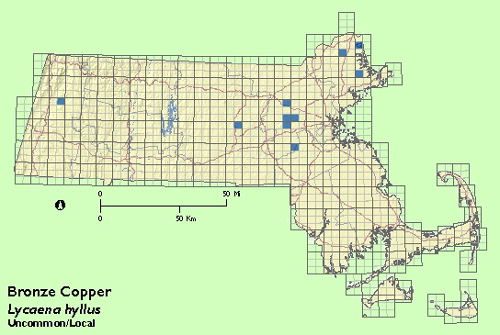Find a Butterfly
Bronze Copper
Lycaena hyllus
Named
Cramer, 1775

Identification
Wingspan: 1 1/4". This species can be differentiated from the other two Massachusetts coppers American Copper (L. phlaeas) and Bog Copper (L. epixanthe) by its larger size and the broad orange marginal band on the underside of the hind wing. The Bronze Copper is sexually dimorphic. The male‘s forewing is dark, coppery purple while that of the female is light orange.
Distribution
Northern Alberta east to Newfoundland and south to eastern Idaho, eastern Colorado, Kentucky, and Maryland. Generally, throughout New England excluding northernmost New Hampshire and most of northern Maine.
Status in Massachusetts
Locally uncommon or rare statewide and apparently absent in the southeastern portion of the state. In general, Bronze Copper was a difficult species to locate during the Atlas period. In fact, only 9 specimens were collected during the 5 year period. In one area of the state, however, Bronze Copper was found with some regularity. The Sudbury River drainage provided 3 specimen records, 2 (NABA) Count sight records, and at least 6 other sight records in the 1986 1990 period. Maximum: 4, 21 October 1990, Concord (Middlesex Co.).
The status of this species in Massachusetts seems always to have been perplexing. In his description Scudder (1889) states "in New England it has never been taken east of the Connecticut Valley, and the reported captures are few" and "this insect is so rare that comparatively little is known of its history . . ." Elsewhere in the account, however, Scudder gives anecdotal information describing the butterfly as "not uncommon" (Springfield) and even "common" (Lenox). Opler‘s County Atlas (1983) records Bronze Copper in the state‘s four westernmost counties as well as in three counties east of the Connecticut River; no records are indicated for southeastern Massachusetts including the Cape and islands.

Flight Period in Massachusetts
Two distinct flight periods: mid June to mid July and early August through mid September. Extreme dates: 15 June and 21 October 1990, Concord (Middlesex Co.), R. Walton.
Larval Food Plants
Curly Dock (Rumex crispus), introduced from Europe, and possibly Water Dock (R. orbiculatus).
Adult Food sources
Information for this species in Massachusetts is currently unavailable.

Habitat
Riparian meadows, marshes, and pondshores.
Life Cycle
EGG: Pale green to white; turban shaped and pitted over its entire surface. OVIPOSITION: Eggs laid singly and variously on leaves, stems, and other plant parts. LARVA: Yellow green with dark dorsal stripe and short bristles. CHRYSALIS: Pale yellowish brown; generally ovoid in shape. OVERWINTERING STAGE: Egg.
During flight periods, adults occasionally visit flowers but are more regularly found sunning on wetland grasses and sedges.
Notes
Although speculative, it maybe instructive to compare several factors in the life histories of the present species and a similar British butterfly, the Large Copper (Lycaena dispar). Both coppers are wetland associates whose host plants are Rumex spp. The extinction of the British population of L. dispar has been directly related to degradation of its fenland habitat. A reintroduction program using Dutch stock on managed fens, although somewhat successful, led one researcher to conclude that different populations of butterflies may well have "subtle specialized needs" with regards to the size and situation of their foodplants (Duffey 1968, 1977). Thus, wholesale draining and reclamation of wetlands is bound to affect this species as it did its British counterpart and less obvious changes, may also be impacting Bronze Copper populations even where habitat and food plant resources seem intact.
Account Author
Richard K. Walton
Additional Information
Read more on this species at the North American Butterfly Association.



